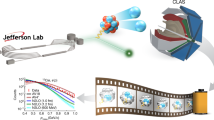Abstract
We have calculated the velocity dependent forces acting between two nuclei that arise due to one-body mechanism of nuclear excitation when they are dragged against one another with constant velocity. The nuclear friction coefficients are then extracted from the velocity dependence of these forces which is found to be strongly linear. The one-body force is calculated by solving the time-dependent Schrödinger equation for all the occupied single-particle states of a nuclear system in a central collision. Each nucleus in this model is assumed to be described by a single-particle Woods-Saxon potential filled with 40 nucleons each. The magnitude of the resulting one-body friction is found to be in between the proximity and surface frictions. The proximity-friction is too small by about an order of magnitude. To check this result, we calculated the one-sided flux from one nucleus to the other. The friction force connected to this flux (i.e. the one-body exchange friction) turns out to be about half or less than the one body friction. We conclude that theproximity-friction grossly underestimates the one-body exchange friction. Furthermore,inelastic excitations are at least as important for one-body dissipation at distances beyond the touching point as is particle exchange.
Similar content being viewed by others
References
Fröbrich, P.: Phys. Rep.116, 337 (1984)
Randrup, J.: Ann. Phys.112, 356 (1978)
Gross, D.H.E.: Z. Physik A — Atoms and Nuclei292, 145 (1979)
Gross, D.H.E.: Nucl. Phys. A240, 472 (1975)
Hofmann, H., Siemens, P.J.: Nucl. Phys. A257, 165 (1976)
Pal, S., Ganguly, N.K.: Nucl. Phys. A370, 175 (1981)
Broglia, R.A., Winther, A.: Nucl. Phys. A182, 112 (1972); Phys. Rep.4C, 154 (1972);
Dietrich, K., Hara, K.: Nucl. Phys. A211, 349 (1973)
Bertsch, G., Schaeffer, R.: Nucl. Phys. A277, 509 (1977)
Jolos, R.V., Schmidt, R., Teichert, J.: Nucl. Phys. A429, 139 (1984)
Cassing, W., Dhar, A.K., Lukasiak, A., Nörenberg, W.: Z. Phys. A — Atoms and Nuclei314, 309 (1983)
Bonche, P., Koonin, S., Negele, J.W.: Phys. Rev. C13, 1226 (1976)
Hölzer, P., Mosel, U., Greiner, W.: Nucl. Phys. A138, 241 (1969)
Brosa, U., Cassing, W.: Z. Phys. A — Atoms and Nuclei307, 167 (1982)
Ko, Che-ming: Phys. Rev. C19, 2417 (1979)
Swiatecki, W.J.: Private communication
Negele, J.W.: Rev. Mod. Phys.54, 913 (1982)
Author information
Authors and Affiliations
Additional information
On leave of absence from Variable Energy Cyclotron Centre, Bhabha Atomic Research Centre, Calcutta, India
The authors are thankful to W. Cassing for providing us with the code ADIP and useful suggestions. Valuable discussions with H.A. Weidenmüller, W.J. Swiatecki and M. Tohyama are also acknowledged. To H. Fiedeldey we are very grateful for improving the English of this paper.
Rights and permissions
About this article
Cite this article
Pal, S., Gross, D.H.E. One-body nuclear friction. Z. Physik A - Atomic Nuclei 329, 349–356 (1988). https://doi.org/10.1007/BF01290240
Received:
Revised:
Issue Date:
DOI: https://doi.org/10.1007/BF01290240



